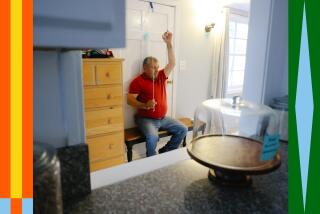For Immigrants, Accent on Speech : Education: Fullerton class teaches English pronunciation to those who wish to speak clearly for professional or personal reasons.
FULLERTON â Sitting around a library table, 10 adults from three continents listened attentively as Susanne Flatley emphasized the importance of the jaw in proper pronunciation.
âIn English, we encourage you to really move your jaw,â Flatley said. âYou have to do that to speak clearly.â
That tip and others offered in a Fullerton class on how to speak without an accent were closely followed at a recent session by a group of immigrants seeking to improve their pronunciation for professional and, in some cases, distinctly personal reasons.
Typical of those pursuing a course of study gaining popularity in immigrant-rich Orange County were Josef Mair, who speaks with a thick Austrian accent, and Dora Harrigan, his wife, whose English is flavored with the Spanish of her native Peru.
Mair said it was his stepson, Bernard, 14, who provided the motivation.
The coupleâs contrasting accents are so startling that Mair, who recently married the boyâs mother, said his stepson is frequently embarrassed when his parents open their mouths.
âI notice when we go to a baseball game that he doesnât want me to speak to people,â said Mair, 49, a salesman.
The Placentia resident lived with that frustration until his wife spotted a notice about the class, which began Oct. 3 at the Hunt Branch Library in Fullerton. It is sponsored by the city of Fullerton Community Services Department.
Students paid $44 each to enroll in the four-week class, which has also been offered in Anaheim and soon will begin in La Palma. Other students in Flatleyâs class hail from Japan, the Philippines, Mexico and Taiwan.
All have jobs dealing with the public, and are frustrated at the repeated explanations they must give to people who do not understand their thickly accented English.
âThe goal in this class is not to become a native American speaker,â Flatley said. âThe goal is to become more intelligible.â
Accent reduction classes are relatively novel in Orange County, despite the areaâs huge influx of immigrants from all over the world in recent years. While some native-born Americans find some foreign accents amusing, the immigrants do not, Flatley said.
âItâs really not a laughing matter,â Flatley said. âMany of these people deal with the public and itâs very frustrating because they have to repeat what they say.â
Harrigan, for example, said that her Spanish-accented English hampers her ability to communicate with the public in her position as a caseworker for the California Department of Economic Development. Dealing with a mixture of Spanish-speaking and English-speaking clients, Harrigan said she sometimes has difficulty making herself understood in English.
âI just want to improve so it will be easier for me to do the job I do,â said Harrigan, who immigrated to the United States 15 years ago from Lima, Peru. âI also feel like I can have a better chance to go to college.â
Speech patterns are formed in childhood from oneâs native language. An accent results when the person learns a new language requiring the production of sounds different from the native language. Spanish-speaking people, for example, have trouble with English words containing the sound of âth,â because there is no âthâ sound in Spanish, Flatley said.
Flatley began teaching accent reduction classes two years ago, using tapes and sound exercises to try to replace existing speech habits that cause an accent with new habit patterns that reduce the accent.
To help accomplish this objective, students follow the format of âPronouncing English as a Second Language,â a San Francisco-originated private course which is offered in most major cities throughout the United States. The program covers three phases: learning to hear and produce the troublesome English sounds, practicing the difficult rhythms and phrasing of English and practicing the new speech patterns in casual conversation.
The class being taught every Tuesday night in Fullerton is only an introduction. During the first class, students recited such troublesome phrases for foreigners as, âOf course, â âI was afraid this would happenâ and âShe hates being late for class.â
Flatley mixes the recitations with more tips for proper pronunciation. The position of the tongue is important. While speaking many foreign languages requires use of the back of the tongue, American English uses the tip of the tongue, Flatley said.
Flatleyâs partner, Jocelyn Piper, using chalk and a blackboard, explained that English is a particularly difficult language to pronounce because it has about 50 sounds but only 26 letters to carry those sounds. The five vowels used in English can be pronounced several ways, depending on the word, Flatley said.
Flatley demonstrated the difficulty in vowel pronunciations by asking her students which one of the vowels in the word âdiplomaâ had the âuhâ sound.
âItâs the âo,â â Mair answered incorrectly.
âIf it was the âo,â it would be âdipluhma,â â Flatley said.
Breaking into small groups, the students recited phrases together and individually, as the teachers listened and corrected. The phrases included such tongue-twisters as âAsk any bashful man if he can dance,â and âA great sound came from the right side of the door.â
Then they practiced difficult words. John Liu, a chemist who immigrated here from Taiwan, stumbled over the simple word âtoe,â pronouncing it âto-eh.â He pronounced it correctly, though, after repeating it.
And Mairâs big nemesis was the word âpail.â He pronounced it âpayul,â but got it right after several more attempts.
At the end of the session, Flatley tried to console wounded egos.
âEnglish is so difficult,â she said, âeven for those of us who grew up speaking it.â
More to Read
Sign up for Essential California
The most important California stories and recommendations in your inbox every morning.
You may occasionally receive promotional content from the Los Angeles Times.










